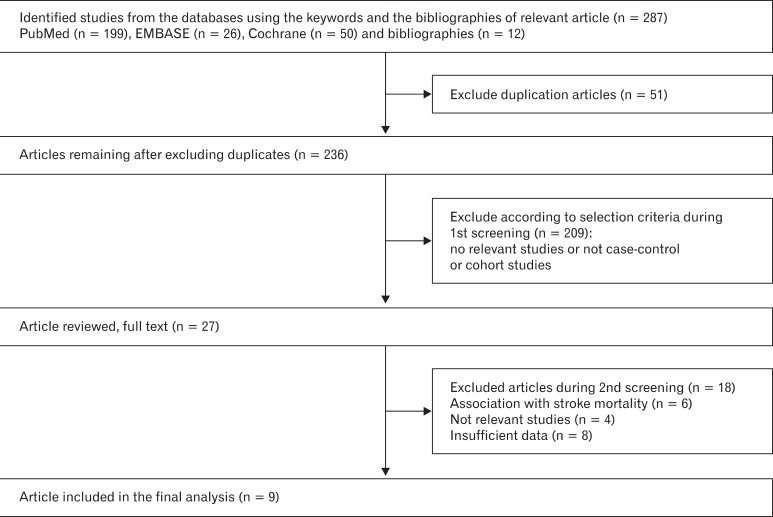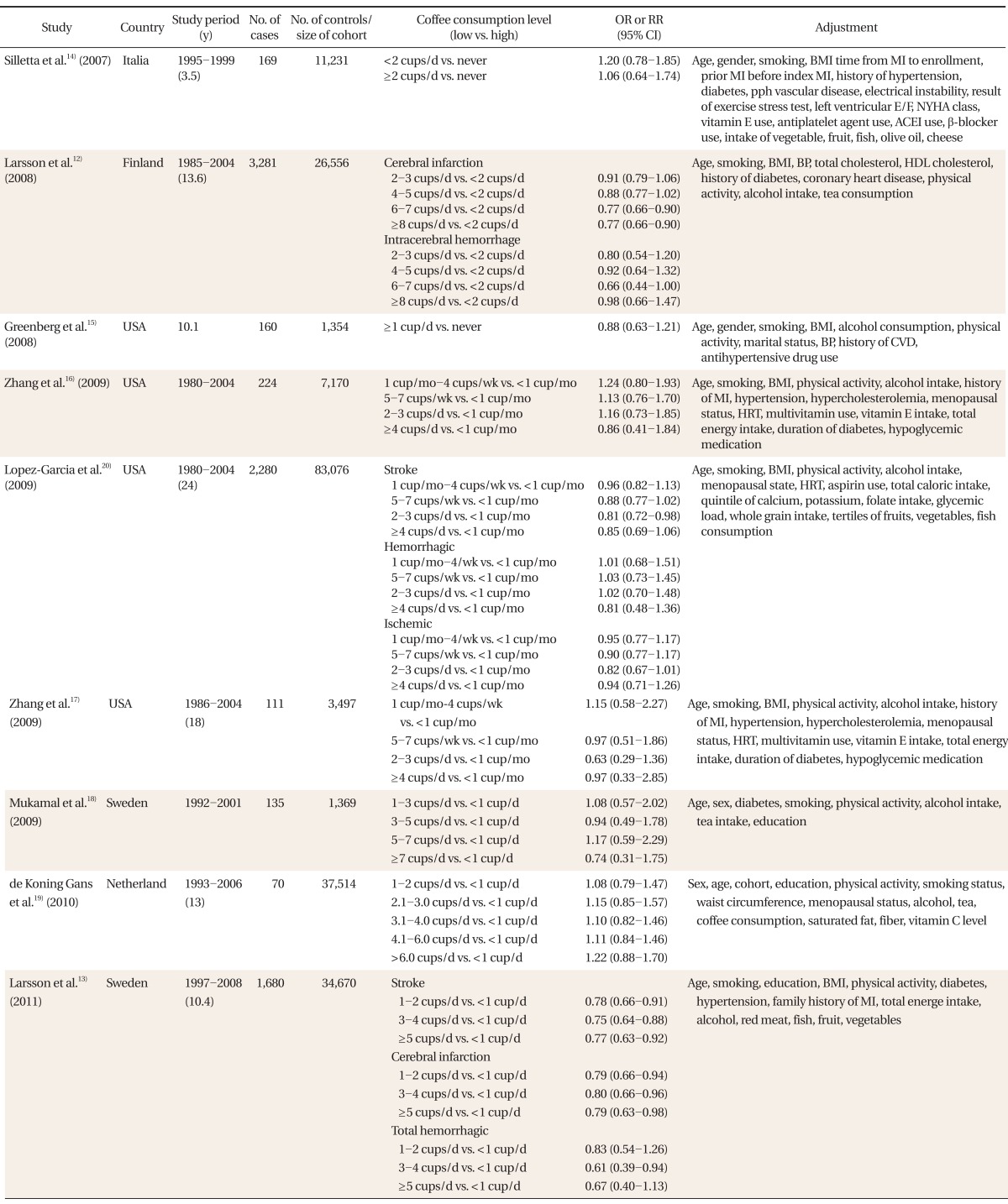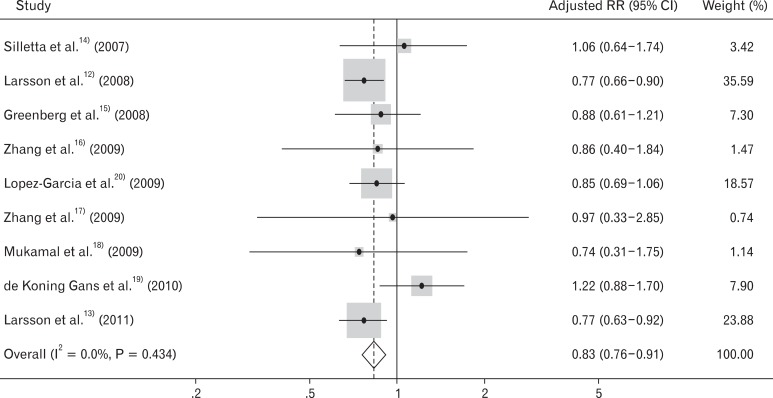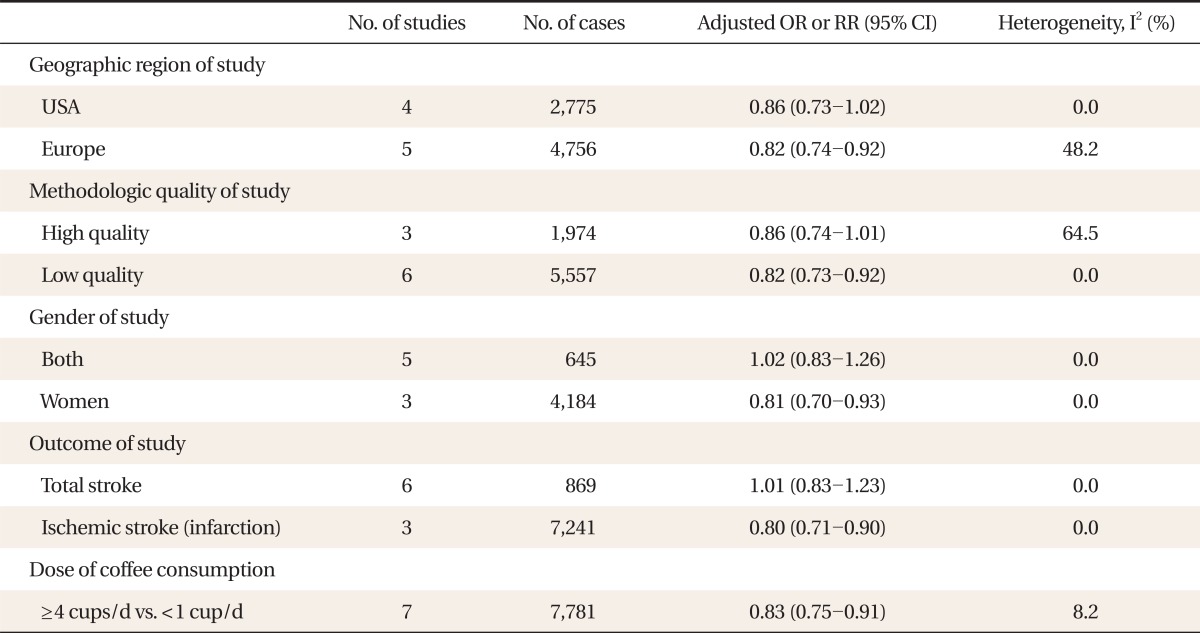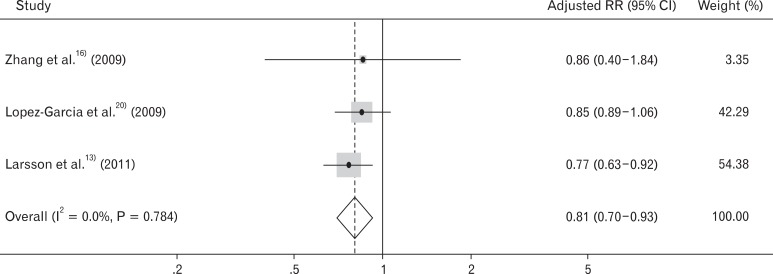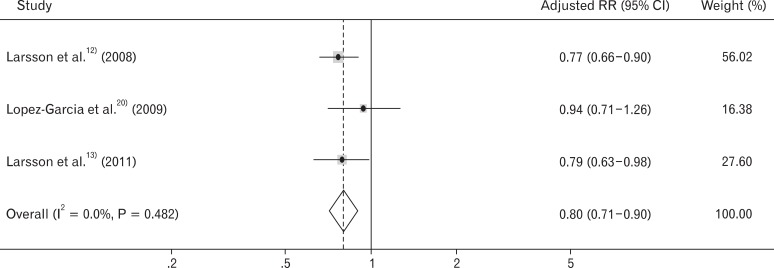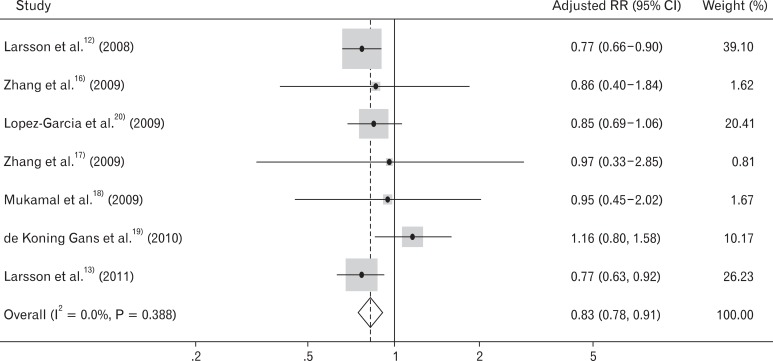Abstract
Background
Coffee is one of the most widely consumed beverages in the world, and contains caffeine and phenolic compounds. Many studies on the association between coffee consumption and risk of stroke have been reported, however, more research is needed to further explore many studies' inconsistent results. Therefore, we conducted a meta-analysis to verify the relationship between coffee consumption and stroke.
Methods
We searched MEDLINE (PubMed), EMBASE, and the Cochrane Library, using the keywords "coffee" or "caffeine" for the exposure factors, and "transient ischemic attack" or "stroke" or "acute cerebral infarction" or "cardiovascular events" for the outcome factors. We included prospective cohort and case-control studies published between 2001 and July 2011 in this review. The search was limited to English language.
Results
Among 27 articles identified for this review, only 9 studies met the inclusion criteria, all of which were cohort studies. When using all cohort studies, the pooled relative risk (RR) of stroke for the highest vs. lowest category of coffee consumption was 0.83 (95% confidence interval [CI], 0.76 to 0.91). When subgroup analysis was performed, for Europeans, increased coffee drinking showed a preventive effect on stroke occurrence with RR 0.82 (95% CI, 0.74 to 0.92); RR for women 0.81 (95% CI, 0.70 to 0.93); for ischemic stroke 0.80 (95% CI, 0.71 to 0.90); and for those drinking 4 cups or more per day 0.83 (95% CI, 0.75 to 0.91).
Conclusion
We found that coffee consumption of 4 cups or more per day showed a preventive effect on stroke in this meta-analysis.
Keywords: Coffee, Stroke, Epidemiologic Studies, Meta-analysis
INTRODUCTION
According to the 2008 coffee market report of the International Coffee Organization, over 2.5 billion cups (30 mL/cup) of coffee are consumed per day worldwide; it is the world's second most popular drink after water. While exerting only small effects on individual health, such high consumption of coffee may have a substantial effect on public health. Thus, many studies on the effects of coffee on the human body are under progress across various fields of study.
Caffeine, a major component of coffee, elevates blood pressure by raising peripheral vascular resistance.1,2) According to a dose-response meta-analysis of trials assessing the relationship between habitual coffee consumption and risk of hypertension, consumption of 1 to 3 cups a day moderately increased the risk of developing hypertension,3) while consumption of more than 3 cups or less than 1 cup did not pose an increased risk. There are also numerous amounts of studies in progress seeking for the effects that coffee has on cardiovascular disease. Several studies found no statistically significant relationship between the two variables,4-6) while some demonstrated a prophylactic effect of coffee on cardiovascular diseases.7) Coffee has been reported to increase insulin sensitivity, thus helping to prevent the development of diabetes mellitus.8-10) Consumption of coffee not only ameliorates inflammatory responses, but also improves vascular endothelial function.11)
Hypertension, cardiovascular diseases, and diabetes mellitus are risk factors of stroke. In light of the evidence of association between the above risk factors and coffee consumption, one can suggest that coffee intake may directly or indirectly have some influence on stroke.
Among studies assessing the relationship between coffee consumption and risk of stroke, 2 cohort studies reported prophylactic effects of coffee consumption on the development of stroke,12,13) while 6 studies showed no significant relationship between the two.14-19) In one cohort study, despite the statistically insignificant relationship between coffee consumption and risk of stroke, stroke risk tended to decrease as coffee consumption increased in women.20) Likewise, a number of studies have been published, but the prophylactic effects of coffee consumption on development of stroke still remains controversial.
The association between coffee consumption and chronic diseases such as hypertension,3) coronary artery disease,21,22) or diabetes mellitus10,23) has been further verified by meta-analyses, but those clarifying the relationship between coffee consumption and the risk of stroke are still lacking. We therefore conducted a meta-analysis of cohort studies on the effect of coffee consumption on the risk of stroke.
METHODS
1. Literature Search
We reviewed articles reporting on the association between coffee consumption and risk of stroke by using the key words, "coffee or caffeine" and "transient ischemic attack (TIA) or stroke" and "acute cerebral infarction or cardiovascular events." We carried out a literature search of the MEDLINE (PubMed), EMBASE, and the Cochrane Library databases. Only case-control and cohort studies were selectively reviewed. The exposure factor was "coffee" or "caffeine," and the result factor was "TIA" or "stroke" or "acute cerebral infarction" or "cardiovascular events."
2. Literature Selection
Of the identified papers, only the case-control and cohort studies published between 2001 and July, 2011 were selected. To be included, the study had to 1) be a prospective cohort study or case-control study; 2) use the exposure factor as the frequency or amount of coffee consumption; 3) and use the result factor as the development of stroke; 4) have reported relative ratios with 95% confidence intervals of stroke incidence. Two of the authors independently reviewed the articles. Disagreement arising during the process of selection was adjudicated by consensus.
For each study, the following data were extracted: author, geographic location of study, study period, age range of participants, sample size, degree of exposure (amount of coffee consumption), variables for adjustment, and relative risks (RRs) of the groups with the highest and lowest level of coffee intake, respectively. The 9-star Newcastle-Ottawa Scale (NOS) was used for quality assessment of each of the included papers.
3. Statistical Analysis
Only cohort studies were selected for use in this study because none of the identified case-control studies fully met the inclusion criteria. One cohort study12) categorized results into cerebral infarction, intracranial hemorrhage, and subdural hemorrhage, thus we only included the RR of cerebral infarction. For two studies3,20) where outcomes were categorized into stroke, cerebral infarction, and cerebral hemorrhage, we used results for the group stroke. Coffee consumption was grouped by a variety of amounts. This meta-analysis selected the groups that consumed the most and the least amount of coffee, respectively, for subgroup analysis to maximize the effect by the amount of coffee consumption.
Heterogeneity was measured using the Higgins I2 statistic by using the following equation:
| I2 = 100% × (Q-df)/Q |
Cochran's Q is a measure of heterogeneity, and df is an expression of the degree of freedom. Values of I2 (%) ranges from 0% to 100% with those >50% being indicative of presence of heterogeneity.
Possible publication bias was evaluated through Begg's funnel plot and with Egger's test. All statistical analyses were conducted using Stata SE ver. 10.0 (Stata Co., College Station, TX, USA).
RESULTS
1. Identified Papers
A total of 9 cohort studies12-20) published from 2001 to July, 2011 were included in this study. The selection process of the articles included in the meta-analysis is configurated in Figure 1. Of a total of 287 papers that were initially identified by searching 3 databases and the reference articles of the searched papers, 9 papers were finally selected for inclusion in the meta-analysis, and 51 duplicates were excluded.
Figure 1.
Flow diagram of identification of relevant studies.
The exclusion criteria implemented for the 1st screening was a paper that was not a case-control or cohort study and that did not have an association with the topic. The next screening consisted of review of all remaining articles to exclude unrelated articles (n = 4), those that investigated mortality of stroke (n = 6), and those with missing data (n = 8). In case of duplicates, we selected the more recently published paper. A total of 9 cohort studies were used in this meta-analysis, the characteristics of which are delineated in Table 1.
Table 1.
Characteristics of studies of coffee consumption and stroke risk included in the final analysis (n = 9).
OR: odds ratio, RR: relative risk, CI: confidence interval, BMI: body mass index, MI: myocardial infarction, NYHA: New York Heart Association, ACEI: angiotensin converting enzyme inhibitor, BP: blood pressure, HDL: high density lipoprotein, CVD: cardiovascular disease, HRT: hormone replacement therapy.
Figure 2 schematically shows the results of this meta-analysis, which indicated a prophylactic effect of high coffee intake (4 or more cups of coffee a day) on stroke incidence (RR, 0.83; 95% confidence interval [CI], 0.76 to 0.91). There was no statistically significant between-study heterogeneity (I2 = 1.2%). Evaluation of possible publication bias through Begg's funnel plot showed no such bias (P = 0.212) within the selected articles.
Figure 2.
Coffee consumption and stroke risk in a meta-analysis of epidemiological studies (n = 9). RR: relative risk, CI: confidence interval.
2. Subgroup Analyses
Papers used for the meta-analysis were categorized into 5 subgroups (Table 2). First, they were analyzed by the country the study took place. One study conducted in the US showed no statistically significant association between coffee consumption and stroke incidence (RR, 0.86; 95% CI, 0.73 to 1.02). On the other hand, a study conducted in Europe demonstrated that coffee consumption provided protection against stroke incidence (RR, 0.82; 95% CI, 0.74 to 0.92).
Table 2.
Subgroup analyses by the type of geographic region of study and methodological quality of studies.
OR: odds ratio, RR: relative risk, CI: confidence interval.
Secondly, the included articles were categorized by quality. Each article was evaluated using the 9-star NOS and allocated to either a high-quality or the low-quality group according to its average NOS score (7.1). The 3 studies that were grouped as high-quality showed no association between coffee consumption and stroke incidence (RR, 0.86; 95% CI, 0.74 to 1.01), while the remaining 6 studies grouped as low-quality demonstrated a prophylactic effect of coffee intake on stroke incidence (RR, 0.82; 95% CI, 0.73 to 0.92).
Thirdly, analysis was conducted by subgroups. With the exclusion of one paper12) that only investigated men, 5 studies that investigated both women and men and 3 studies that only investigated women were selected for analysis. Studies that included both sexes were unable to demonstrate a statistically significant association (RR, 1.02; 95% CI, 0.83 to 1.26), while the ones that included only the female sex showed a prophylactic effect on the development of stroke exclusively in the group with high coffee intake (RR, 0.81; 95% CI, 0.70 to 0.93) (Figure 3).
Figure 3.
Coffee consumption and stroke risk in a subgroup analysis of women groups (n = 3). RR: relative risk, CI: confidence interval.
Fourthly, subgroup analysis was conducted according to results. Two13,20) of the included papers categorized results into stroke, cerebral infarction, and cerebral hemorrhage. Thus, the RRs of cerebral infarction of the two papers were combined with that of one other paper,12) in which the outcome was cerebral infarction, for analysis. The remaining 6 papers showed their outcome as stroke. The group with the outcome of stroke showed no significant association (RR, 1.01; 95% CI, 0.83 to 1.23), while the group with the outcome of cerebral infarction showed a statistically significant preventive effect of coffee on stroke (RR, 0.80; 95% CI, 0.71 to 0.90) (Figure 4).
Figure 4.
Coffe consumption and stroke risk in a subgroup analysis by the outcome of studies (Ischemic stroke group, n = 3). RR: relative risk, CI: confidence interval.
Lastly, in exploration of the effect of coffee by amount of consumption, we underwent a subgroup analysis to compare the group that drank 4 or more cups of coffee and of that which drank less than 1 cup per day; the results showed an inverse association between coffee consumption and stroke incidence with a RR of 0.83 (95% CI, 0.75 to 0.91) (Figure 5).
Figure 5.
Coffee consumption and stroke risk in a subgroup analysis (≥4 cups/d vs. <1 cup/d, n = 7). RR: relative risk, CI: confidence interval.
DISCUSSION
Caffeine, as the major component of coffee, not only elevates peripheral vascular resistance,1) but also diminishes cerebral blood flow via its constricting effect on cerebral vessels. According to one clinical study, cerebral blood flow abruptly decreased within 30 to 90 minutes after consuming 250 to 500 mg of caffeine.24) One other clinical study reported that caffeine lowered cerebral blood flow during rest.25) Moreover, moderate consumption of coffee can possibly lead to hypertension.3) Although coffee consumption has been known to decrease cerebral blood flow and pose a risk for hypertension, analysis of 3 articles of high quality showed that there was no significant relationship between coffee consumption and risk of stroke and that of 6 articles of relatively low quality showed a prophylactic effect of coffee consumption on stroke incidence. This meta-analysis showed that higher coffee consumption had a significant though not much preventive effect on stroke occurrence as of RR 0.83 (95% CI, 0.76 to 0.91).
Other than caffeine, coffee contains anti-oxidant phenol products which improves endothelial function, thereby preventing atherosclerosis.26,27) One study also reported that C-reactive protein and adhesion molecules of white blood cells were detected in lower amounts in those with higher coffee intake irrelevant of caffeine content, thus indicating that coffee consumption decreases inflammatory responses.11) It has been widely known than inflammatory responses are elevated in stroke patients. One can conclude from the results that there is some other component in coffee besides caffeine that is preventive of stroke incidence.
As indirect evidence of the prophylactic effect of coffee consumption on stroke incidence, there have been several papers reporting the association between coffee intake and risk factors of stroke such as insulin sensitivity, diabetes mellitus, and cardiovascular diseases. Coffee maximizes insulin sensitivity, and recent studies demonstrated the prophylactic effect of coffee intake on development of diabetes mellitus.8-10) A meta-analysis concluded that coffee consumption did not provided any prophylactic effect on cardiovascular diseases but did not pose an increased risk either.4-6,21) Some of the 9 selected articles used for the current meta-analysis did not make any adjustment for risk factors of stroke, which may have exerted either a direct or indirect effect on the shown results of the statistical analysis.
This meta-analysis has a few limitations. First, we only analyzed 9 articles that examined the association between coffee and risk of stroke, and they had been published between 2003 and 2011. However, considering that the analysis included mostly high-quality papers (NOS ≥ 7), the small sample size would not pose any challenge to establishing the results. Secondly, all 9 studies evaluated in this study were conducted in Europe or the US, thus are unable to represent the Asian population. A survey conducted by the World Resources Institute in 2008 showed that the US and various European countries accounted for most of the top 50 countries listed in the order of coffee consumption per capita; it is reasonable to think that western countries primarily represent the coffee consuming population. Thirdly, there are different types of coffee by its content and method of preparation: decaffeinated, caffeinated, boiled, and filtered, possibly providing variability in the chemical composition of the beverage. Such a source of variability may have influenced the results. Fourthly, each of the studies included in this meta-analysis differently categorized the amount of coffee consumption with the highest-level group consuming either 2 cups or more, 4 cups or more, or 8 cups or more. On this account, a subgroup analysis was conducted only comparing the group that consumed 4 or more cups of coffee per day and the group that consumed less than 1 cup per day; the former was shown to provide protection against stroke incidence with a RR of 0.83.
Coffee intake is consistently on the rise with only an insufficient amount of epidemiological studies in progress. Despite the limitations listed above, this meta-analysis was significant, as it was the first meta-analysis exploring the association between coffee consumption and risk of stroke. Owing not only to the lack of epidemiological studies assessing the relationship between coffee consumption and reduced deaths due to stroke but also the pathophysiological difference between cerebral hemorrhage and cerebral infarction, additional research is needed in the future.
Footnotes
No potential conflict of interest relevant to this article was reported.
References
- 1.Pincomb GA, Lovallo WR, Passey RB, Whitsett TL, Silverstein SM, Wilson MF. Effects of caffeine on vascular resistance, cardiac output and myocardial contractility in young men. Am J Cardiol. 1985;56:119–122. doi: 10.1016/0002-9149(85)90578-8. [DOI] [PubMed] [Google Scholar]
- 2.Hartley TR, Lovallo WR, Whitsett TL. Cardiovascular effects of caffeine in men and women. Am J Cardiol. 2004;93:1022–1026. doi: 10.1016/j.amjcard.2003.12.057. [DOI] [PubMed] [Google Scholar]
- 3.Zhang Z, Hu G, Caballero B, Appel L, Chen L. Habitual coffee consumption and risk of hypertension: a systematic review and meta-analysis of prospective observational studies. Am J Clin Nutr. 2011;93:1212–1219. doi: 10.3945/ajcn.110.004044. [DOI] [PubMed] [Google Scholar]
- 4.Lopez-Garcia E, van Dam RM, Willett WC, Rimm EB, Manson JE, Stampfer MJ, et al. Coffee consumption and coronary heart disease in men and women: a prospective cohort study. Circulation. 2006;113:2045–2053. doi: 10.1161/CIRCULATIONAHA.105.598664. [DOI] [PubMed] [Google Scholar]
- 5.Reis JP, Loria CM, Steffen LM, Zhou X, van Horn L, Siscovick DS, et al. Coffee, decaffeinated coffee, caffeine, and tea consumption in young adulthood and atherosclerosis later in life: the CARDIA study. Arterioscler Thromb Vasc Biol. 2010;30:2059–2066. doi: 10.1161/ATVBAHA.110.208280. [DOI] [PMC free article] [PubMed] [Google Scholar]
- 6.Sugiyama K, Kuriyama S, Akhter M, Kakizaki M, Nakaya N, Ohmori-Matsuda K, et al. Coffee consumption and mortality due to all causes, cardiovascular disease, and cancer in Japanese women. J Nutr. 2010;140:1007–1013. doi: 10.3945/jn.109.109314. [DOI] [PubMed] [Google Scholar]
- 7.Woodward M, Tunstall-Pedoe H. Coffee and tea consumption in the Scottish Heart Health Study follow up: conflicting relations with coronary risk factors, coronary disease, and all cause mortality. J Epidemiol Community Health. 1999;53:481–487. doi: 10.1136/jech.53.8.481. [DOI] [PMC free article] [PubMed] [Google Scholar]
- 8.Arnlov J, Vessby B, Riserus U. Coffee consumption and insulin sensitivity. JAMA. 2004;291:1199–1201. doi: 10.1001/jama.291.10.1199-b. [DOI] [PubMed] [Google Scholar]
- 9.van Dam RM, Feskens EJ. Coffee consumption and risk of type 2 diabetes mellitus. Lancet. 2002;360:1477–1478. doi: 10.1016/S0140-6736(02)11436-X. [DOI] [PubMed] [Google Scholar]
- 10.van Dam RM, Hu FB. Coffee consumption and risk of type 2 diabetes: a systematic review. JAMA. 2005;294:97–104. doi: 10.1001/jama.294.1.97. [DOI] [PubMed] [Google Scholar]
- 11.Lopez-Garcia E, van Dam RM, Qi L, Hu FB. Coffee consumption and markers of inflammation and endothelial dysfunction in healthy and diabetic women. Am J Clin Nutr. 2006;84:888–893. doi: 10.1093/ajcn/84.4.888. [DOI] [PubMed] [Google Scholar]
- 12.Larsson SC, Mannisto S, Virtanen MJ, Kontto J, Albanes D, Virtamo J. Coffee and tea consumption and risk of stroke subtypes in male smokers. Stroke. 2008;39:1681–1687. doi: 10.1161/STROKEAHA.107.504183. [DOI] [PubMed] [Google Scholar]
- 13.Larsson SC, Virtamo J, Wolk A. Coffee consumption and risk of stroke in women. Stroke. 2011;42:908–912. doi: 10.1161/STROKEAHA.110.603787. [DOI] [PubMed] [Google Scholar]
- 14.Silletta MG, Marfisi R, Levantesi G, Boccanelli A, Chieffo C, Franzosi M, et al. Coffee consumption and risk of cardiovascular events after acute myocardial infarction: results from the GISSI (Gruppo Italiano per lo Studio della Sopravvivenza nell'Infarto miocardico)-Prevenzione trial. Circulation. 2007;116:2944–2951. doi: 10.1161/CIRCULATIONAHA.107.712976. [DOI] [PubMed] [Google Scholar]
- 15.Greenberg JA, Chow G, Ziegelstein RC. Caffeinated coffee consumption, cardiovascular disease, and heart valve disease in the elderly (from the Framingham Study) Am J Cardiol. 2008;102:1502–1508. doi: 10.1016/j.amjcard.2008.07.046. [DOI] [PubMed] [Google Scholar]
- 16.Zhang WL, Lopez-Garcia E, Li TY, Hu FB, van Dam RM. Coffee consumption and risk of cardiovascular events and all-cause mortality among women with type 2 diabetes. Diabetologia. 2009;52:810–817. doi: 10.1007/s00125-009-1311-1. [DOI] [PMC free article] [PubMed] [Google Scholar]
- 17.Zhang W, Lopez-Garcia E, Li TY, Hu FB, van Dam RM. Coffee consumption and risk of cardiovascular diseases and all-cause mortality among men with type 2 diabetes. Diabetes Care. 2009;32:1043–1045. doi: 10.2337/dc08-2251. [DOI] [PMC free article] [PubMed] [Google Scholar]
- 18.Mukamal KJ, Hallqvist J, Hammar N, Ljung R, Gemes K, Ahlbom A, et al. Coffee consumption and mortality after acute myocardial infarction: the Stockholm Heart Epidemiology Program. Am Heart J. 2009;157:495–501. doi: 10.1016/j.ahj.2008.11.009. [DOI] [PubMed] [Google Scholar]
- 19.de Koning Gans JM, Uiterwaal CS, van der Schouw YT, Boer JM, Grobbee DE, Verschuren WM, et al. Tea and coffee consumption and cardiovascular morbidity and mortality. Arterioscler Thromb Vasc Biol. 2010;30:1665–1671. doi: 10.1161/ATVBAHA.109.201939. [DOI] [PubMed] [Google Scholar]
- 20.Lopez-Garcia E, Rodriguez-Artalejo F, Rexrode KM, Logroscino G, Hu FB, van Dam RM. Coffee consumption and risk of stroke in women. Circulation. 2009;119:1116–1123. doi: 10.1161/CIRCULATIONAHA.108.826164. [DOI] [PMC free article] [PubMed] [Google Scholar]
- 21.Wu JN, Ho SC, Zhou C, Ling WH, Chen WQ, Wang CL, et al. Coffee consumption and risk of coronary heart diseases: a meta-analysis of 21 prospective cohort studies. Int J Cardiol. 2009;137:216–225. doi: 10.1016/j.ijcard.2008.06.051. [DOI] [PubMed] [Google Scholar]
- 22.Sofi F, Conti AA, Gori AM, Eliana Luisi ML, Casini A, Abbate R, et al. Coffee consumption and risk of coronary heart disease: a meta-analysis. Nutr Metab Cardiovasc Dis. 2007;17:209–223. doi: 10.1016/j.numecd.2006.07.013. [DOI] [PubMed] [Google Scholar]
- 23.Huxley R, Lee CM, Barzi F, Timmermeister L, Czernichow S, Perkovic V, et al. Coffee, decaffeinated coffee, and tea consumption in relation to incident type 2 diabetes mellitus: a systematic review with meta-analysis. Arch Intern Med. 2009;169:2053–2063. doi: 10.1001/archinternmed.2009.439. [DOI] [PubMed] [Google Scholar]
- 24.Mathew RJ, Wilson WH. Caffeine induced changes in cerebral circulation. Stroke. 1985;16:814–817. doi: 10.1161/01.str.16.5.814. [DOI] [PubMed] [Google Scholar]
- 25.Laurienti PJ, Field AS, Burdette JH, Maldjian JA, Yen YF, Moody DM. Relationship between caffeine-induced changes in resting cerebral perfusion and blood oxygenation level-dependent signal. AJNR Am J Neuroradiol. 2003;24:1607–1611. [PMC free article] [PubMed] [Google Scholar]
- 26.Bonita JS, Mandarano M, Shuta D, Vinson J. Coffee and cardiovascular disease: in vitro, cellular, animal, and human studies. Pharmacol Res. 2007;55:187–198. doi: 10.1016/j.phrs.2007.01.006. [DOI] [PubMed] [Google Scholar]
- 27.Gomez-Ruiz JA, Leake DS, Ames JM. In vitro antioxidant activity of coffee compounds and their metabolites. J Agric Food Chem. 2007;55:6962–6969. doi: 10.1021/jf0710985. [DOI] [PubMed] [Google Scholar]



